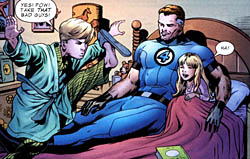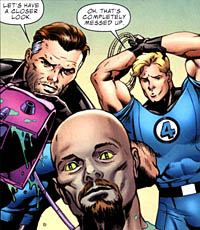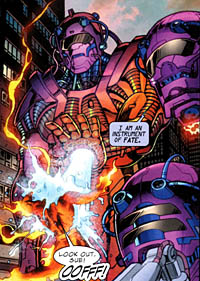 Written by Jonathan Hickman
Written by Jonathan Hickman
Art by Dale Eaglesham
32 pages, color
Published by Marvel Comics
I can’t remember the last time I read Fantastic Four on an ongoing basis. It was probably back when Walter Simonson wrote the book, and that run ended in 1991. I’ve certainly heard good things about some of the runs over the years since then, but it hasn’t been until Jonathan Hickman took over that I’ve decided to give the title another stab. Hickman’s work on books like Pax Romana and Secret Warriors promised, if nothing else, that it wouldn’t just be more of the same old superheroics.
 What do you do when you’re the smartest man on the planet but you still can’t solve everything? It’s a problem that’s haunted Reed Richards for quite some time, even as he continues to try and stop wrongdoers and generally fix the rest of the world. One of his inventions may have finally solved that dilemma, though. Maybe the secret to solving all the problems in the world is to find an infinite number of people who are equally as smart?
What do you do when you’re the smartest man on the planet but you still can’t solve everything? It’s a problem that’s haunted Reed Richards for quite some time, even as he continues to try and stop wrongdoers and generally fix the rest of the world. One of his inventions may have finally solved that dilemma, though. Maybe the secret to solving all the problems in the world is to find an infinite number of people who are equally as smart?
Right off the bat, I like that Hickman’s got multiple themes and plots running through his first issue, even though they all interconnect with one another. This isn’t just a story about Reed trying to fix the world, it’s also one about the relationships between fathers and their children, and we get to see that not only between Reed and his own two kids, but between the Wizard and his "children" as well as Reed and his own father. It’s that story that provides the strongest moment of the first issue, in fact, as we see just how the Wizard views his children and his plans for them. It’s there that it begins to feel like Hickman’s really putting some thought into the series, that it’s going to be more than just the Fantastic Four smacking around bad guys.
 Hickman’s idea of the Council is such a smart one that honestly, it surprises me that it hasn’t been done before. (If it has, I’ve never encountered it in regards to Fantastic Four.) I appreciate it in part because it’s a clever, fun idea that opens up all sorts of possibilities. It’s also good, though, because of how you can compare it to the encounter with the Wizard in this issue. It’s the sort of idea that right from the start you can see never ending well, but getting there is certainly going to be half of the fun. Plus, Hickman hasn’t lost sight of the idea of this being a team book; the focus may be on Reed, but there’s smaller moments for all the characters. Even little Valeria Richards gets her moment to shine, in such a way that keeps her both charming and creepy.
Hickman’s idea of the Council is such a smart one that honestly, it surprises me that it hasn’t been done before. (If it has, I’ve never encountered it in regards to Fantastic Four.) I appreciate it in part because it’s a clever, fun idea that opens up all sorts of possibilities. It’s also good, though, because of how you can compare it to the encounter with the Wizard in this issue. It’s the sort of idea that right from the start you can see never ending well, but getting there is certainly going to be half of the fun. Plus, Hickman hasn’t lost sight of the idea of this being a team book; the focus may be on Reed, but there’s smaller moments for all the characters. Even little Valeria Richards gets her moment to shine, in such a way that keeps her both charming and creepy.
 Dale Eaglesham’s art is a little more uneven because it both does and doesn’t work for me, depending on the subject. Eaglesham’s at his best when tackling things like the giant robots that attack the Fantastic Four; he channels his inner Jack Kirby for this, designing them with all sorts of gears, pistons, rods, and zig-zags. They look strange and menacing at the same time, and that’s exactly what robots in Fantastic Four should look like. He’s good with physical storytelling here as well; the opening scene of a young Reed afraid to jump towards his father really shows the tension and fear from Reed in a visual manner, enhancing the script for the scene. I also like how the present-day Reed has a stubbly beard, it’s a simple but nice redesign of the character’s face.
Dale Eaglesham’s art is a little more uneven because it both does and doesn’t work for me, depending on the subject. Eaglesham’s at his best when tackling things like the giant robots that attack the Fantastic Four; he channels his inner Jack Kirby for this, designing them with all sorts of gears, pistons, rods, and zig-zags. They look strange and menacing at the same time, and that’s exactly what robots in Fantastic Four should look like. He’s good with physical storytelling here as well; the opening scene of a young Reed afraid to jump towards his father really shows the tension and fear from Reed in a visual manner, enhancing the script for the scene. I also like how the present-day Reed has a stubbly beard, it’s a simple but nice redesign of the character’s face.
On the other hand, Reed seems to have also turned into an overly muscled, standard superhero character. It’s the one big weakness of Eaglesham’s art in this issue, that if you’re a superhero you also spend twelve hours a day in the gym. Johnny Storm’s biceps being as large as his head is a laughably ludicrous moment, and a studly Reed Richards feels equally wrong. Remembering how to draw normal people is the one thing Eaglesham needs to do to make the art look just right.
All in all, this is a strong start to Hickman and Eaglesham’s run on Fantastic Four. I’m particularly impressed with Hickman’s writing here, and I think in just a single issue he’s proven himself ready to take over one of Marvel’s flagship titles. If you haven’t read Fantastic Four in a while, it’s definitely worth dipping into and giving a shot.
